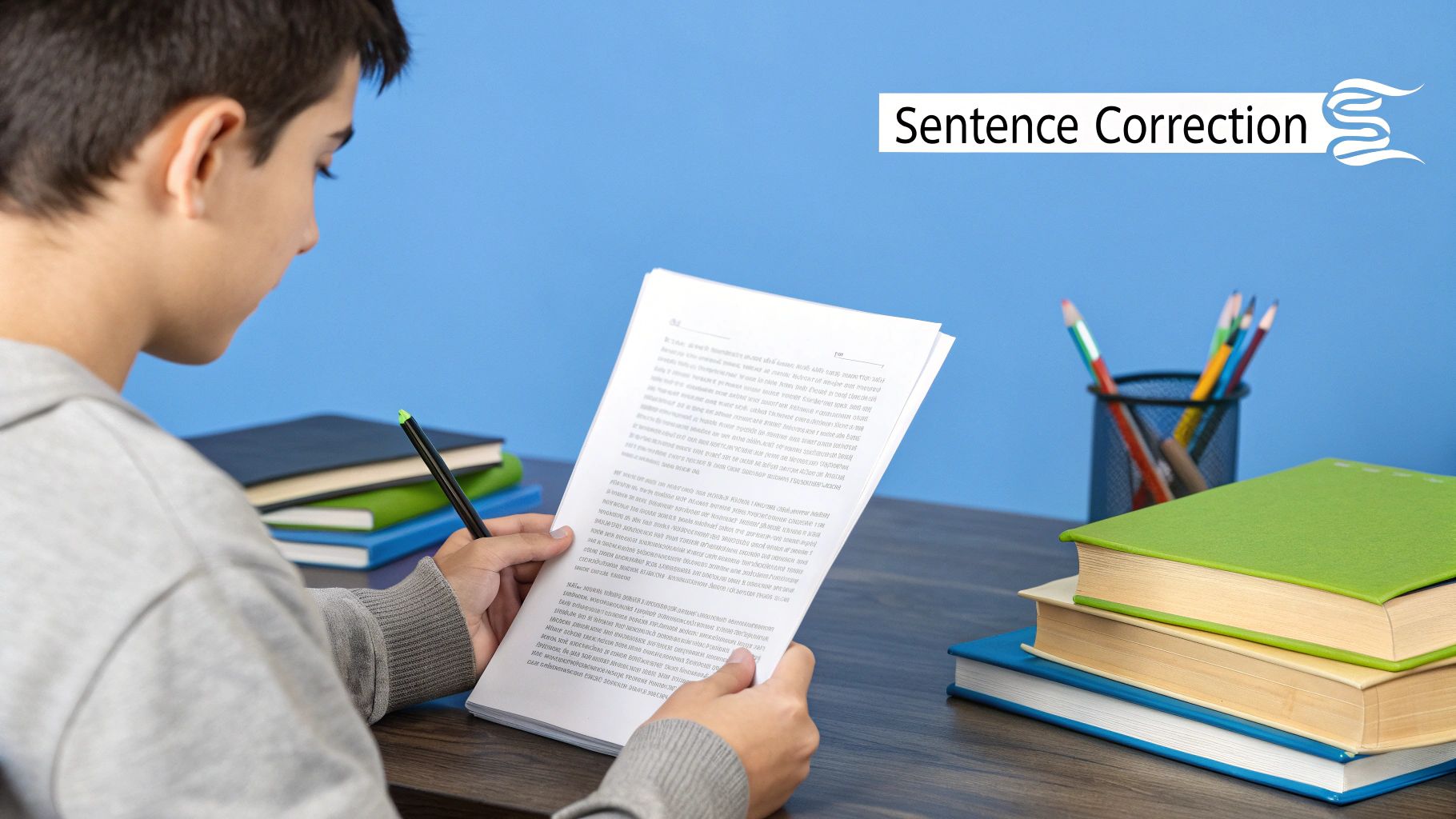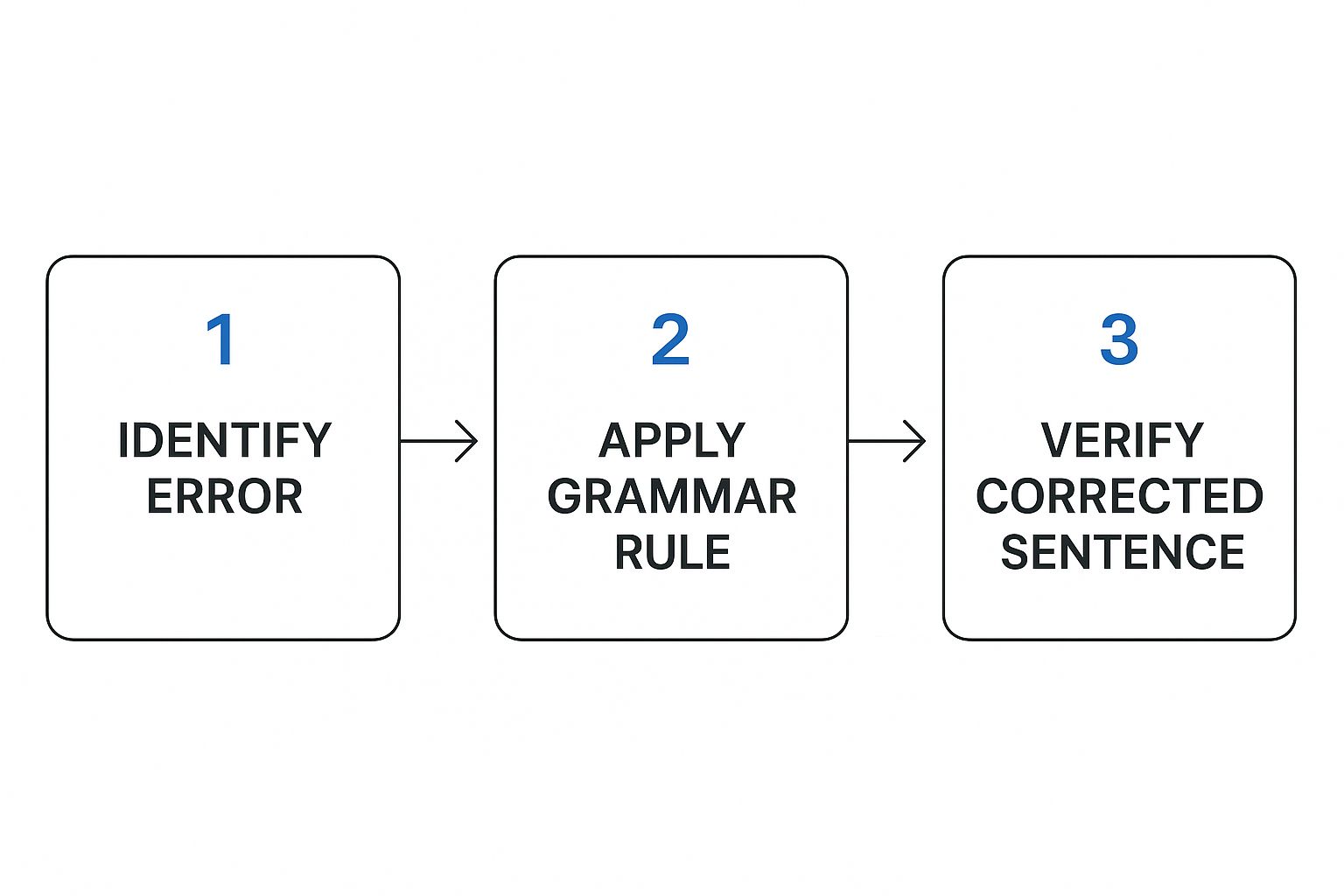Why Sentence Correction Makes or Breaks Your Credibility

Grammatical errors can significantly impact how others perceive your writing, and ultimately, your credibility. Think of your writing as a tailored suit: even a small flaw can detract from the overall impression. In written communication, readers often quickly judge a writer's credibility based on the accuracy of their sentences. Correct sentences are not just about following rules; they're about building trust with your audience and ensuring your message is clearly understood.
The Psychology of Sentence Errors
Why are grammatically correct sentences so important for credibility? Psychological research suggests errors disrupt a reader's cognitive flow. This disruption can create a negative emotional response, leading to distrust and reduced engagement with the content. A poorly written email, for example, might make a job applicant seem careless. Similarly, grammatical errors in a report can undermine the perceived value of the information presented.
The Impact on Communication
The importance of accurate sentences applies to all written communication. Whether you're writing a college application essay, a business proposal, or a social media post, the correctness of your sentences directly affects how your message is received. As the need for clear and accurate communication increases, so does the value of effective sentence correction. The global language services market, including translation and localization, is expected to be worth between USD 131.75 billion and USD 144.19 billion by 2032. This growth highlights the increasing importance of precise language in our interconnected world. Learn more about the growing language services market here.
The Real-World Consequences
The consequences of sentence errors can be substantial. In professional settings, errors can lead to missed opportunities, miscommunication, and reputational damage. By prioritizing sentence accuracy and mastering effective sentence correction, you can strengthen your credibility, improve your communication, and achieve greater success in your academic and professional life. Taking the time to refine your writing is a worthwhile investment in your future.
Spotting the Sentence Killers Most Writers Miss
Beyond simple typos, more insidious errors lurk in our writing, often slipping past even seasoned writers. These hidden "sentence killers" can significantly impact clarity and credibility. By understanding these common pitfalls, you can dramatically improve your writing's effectiveness.
Run-On Sentences: Taming the Ramblers
Run-on sentences, sometimes called fused sentences, combine multiple independent clauses without proper punctuation or conjunctions. They can make your writing feel breathless and disorganized. For example, "The dog barked the cat hissed the bird flew away" is a run-on sentence.
Correcting this requires breaking it down into separate sentences or using appropriate conjunctions and punctuation: "The dog barked. The cat hissed. The bird flew away." or "The dog barked, and the cat hissed as the bird flew away."
Subject-Verb Disagreement: Keeping Things in Harmony
Another frequent offender is subject-verb disagreement. This occurs when the verb doesn't agree in number with its subject. This might seem trivial, but it can create confusion.
For example, "The group of students are going on a trip" is incorrect. The subject "group" is singular, so the correct verb is "is": "The group of students is going on a trip." This simple correction ensures grammatical accuracy. You might be interested in: How to master sentence structure.
Misplaced Modifiers: Putting Things in Their Place
Misplaced modifiers attach themselves to the wrong word in a sentence, leading to unintended and sometimes humorous meanings. Consider this example: "Walking down the street, the tree branch fell on my head." The modifier "walking down the street" incorrectly modifies "tree branch."
The correct sentence would be: "Walking down the street, I was hit by a falling tree branch." Clear modifier placement ensures the reader understands precisely what you mean.
Identifying Your Personal Error Patterns
While recognizing these common sentence killers is important, identifying your specific writing weaknesses is crucial for targeted improvement. Keep track of the types of errors you make most frequently.
This self-awareness allows you to develop personalized editing strategies. By focusing on your personal patterns, you'll correct sentences more effectively and improve your writing overall.
To help you further, here's a handy guide:
The following table provides a quick reference for identifying and correcting common sentence errors:
The Sentence Error Detection Guide
Your field manual for identifying and fixing the most common sentence errors that undermine your writing effectiveness
| Error Type | Definition | Example of Incorrect Usage | Corrected Version | Identification Tip |
|---|---|---|---|---|
| Run-on Sentence | Two or more independent clauses joined incorrectly. | The dog barked the cat hissed. | The dog barked. The cat hissed. OR The dog barked, and the cat hissed. | Look for sentences that feel too long or lack proper punctuation/conjunctions. |
| Subject-Verb Disagreement | Verb does not agree in number with its subject. | The group of students are going. | The group of students is going. | Identify the subject and ensure the verb matches in singularity or plurality. |
| Misplaced Modifier | A modifier that is not clearly attached to the word it modifies. | Walking down the street, the tree branch fell on my head. | Walking down the street, I was hit by a falling tree branch. | Ask yourself what the modifier is describing. Does it make logical sense? |
This table summarizes the key sentence errors discussed and provides practical examples for easy identification and correction. By using this guide, you can significantly enhance your writing clarity and avoid these common pitfalls.
The Foolproof System to Correct the Sentence Every Time
Forget vague grammar advice. This section offers a systematic, three-step approach to sentence correction that consistently delivers results, no matter the writing task. It distills the techniques used by professional editors and writing coaches into a clear and manageable process.
Identify the Error
The first step is accurately pinpointing the problem. Is it a run-on sentence, rambling on without proper punctuation? Perhaps it's a subject-verb disagreement, creating a grammatical mismatch. Or maybe a misplaced modifier is subtly changing the sentence's meaning. Identifying the core issue is crucial, just like a doctor diagnosing an illness before prescribing treatment.
Apply the Grammar Rule
Once you’ve identified the error, apply the correct grammar rule. This requires understanding sentence structure and its underlying principles. For instance, fixing a run-on sentence might involve using commas, semicolons, conjunctions, or even creating separate sentences. Correcting subject-verb disagreement means identifying the subject and using the corresponding verb form. Think of this stage as selecting the right tool and applying it precisely. Interestingly, the language services market, specifically interpretation services, is growing rapidly. By 2025, interpretations are projected to make up about 32.1% of this market, reflecting a rising need for accurate cross-language communication. You can explore more statistics here.
Verify the Corrected Sentence
The final step is ensuring the corrected sentence is grammatically sound, clear, and conveys your intended meaning. This involves carefully rereading, checking for lingering errors, and ensuring the correction hasn’t introduced new problems. This verification process is like a final quality check before publishing. The infographic below visualizes these steps:

This infographic illustrates the sequential process: identify the error, apply the correct rule, and verify the result. Following these steps transforms sentence correction from a challenge into a manageable process, allowing you to write with increased confidence and clarity.
Practical Examples and Application
Let's apply this system with some examples:
-
Incorrect: "The meeting was long and it was boring."
-
Error: Run-on sentence
-
Corrected: "The meeting was long and boring." (Using a coordinating conjunction) or "The meeting was long; it was boring." (Using a semicolon)
-
Incorrect: "Each of the students are responsible for their own work."
-
Error: Subject-verb disagreement
-
Corrected: "Each of the students is responsible for their own work." (Matching singular subject "each" with singular verb "is")
-
Incorrect: "Driving down the road, the billboard caught my eye."
-
Error: Misplaced modifier
-
Corrected: "Driving down the road, I noticed the billboard." (Clearly attaching the modifier to "I")
By consistently using this three-step system and studying these examples, you’ll develop a sharp eye for errors and the skills to correct them. This will significantly improve your writing's clarity, impact, and overall effectiveness.
Digital Arsenal: Tools That Actually Fix Your Sentences

Finding the right sentence correction tool can feel like searching for a needle in a haystack. This section helps you cut through the noise and discover the tools that truly deliver. We'll explore their strengths and weaknesses, offering practical advice based on expert insights and thorough testing.
Grammar Checkers: Your Initial Safety Net
Grammar checkers are your first line of defense against common errors. They catch typos, subject-verb disagreements, and punctuation mistakes. Most word processors include built-in grammar checkers, offering a convenient starting point. For more advanced analysis, dedicated grammar checking software and online platforms are available. If you're looking to improve your grammar skills, you might find this resource helpful: How to master grammar checking.
Beyond basic grammar, style analyzers help you refine your writing for clarity and impact. They identify passive voice, weak verbs, and overly complex sentences, transforming functional prose into polished, professional writing. These tools are especially useful for academic papers, business communications, and any content where precision matters.
Style Analyzers: Polishing Your Prose
AI Writing Assistants: The Next Generation
AI writing assistants, powered by artificial intelligence and large language models, represent the latest advancement in sentence correction. These tools offer sophisticated feedback on grammar, style, tone, and even plagiarism. However, it's important to use them critically, as AI is still under development and can sometimes provide inaccurate advice. The impact of AI on language services is undeniable, with the global large language model market projected to reach $123.09 billion by 2034. You can find more statistics on this growing market here.
The following table provides a comparison of various sentence correction tools:
Introduction to Table: To help you select the right tool, we've compiled a comparison of leading sentence correction options, evaluating their strengths and limitations based on real-world testing.
| Tool Name | Best For | Key Features | Accuracy Rating | Price Range | Limitations |
|---|---|---|---|---|---|
| Grammarly | Everyday writing, academic papers, business documents | Grammar and spelling checks, plagiarism detection, style suggestions | High | Free and paid versions | Can sometimes overcorrect or offer inappropriate suggestions |
| ProWritingAid | Fiction and non-fiction writers, bloggers | Grammar and style checks, readability analysis, in-depth reports | Medium | Free and paid versions | Interface can be overwhelming for beginners |
| Hemingway Editor | Simplifying and clarifying writing | Highlights complex sentences, passive voice, adverbs, and weak verbs | Medium | Free and paid versions | Limited grammar checking capabilities |
| QuillBot | Paraphrasing and rewriting | Rephrases sentences and paragraphs, offers multiple writing modes | Medium | Free and paid versions | May alter the original meaning of the text |
Conclusion of Table: As you can see, each tool has its own strengths and weaknesses. Consider your specific writing needs and budget when making your decision.
Choosing The Right Tool For Your Needs
The ideal sentence correction tool depends on your individual writing goals. Grammar checkers are suitable for general writing, while style analyzers and AI writing assistants are better suited for more demanding tasks. Experimenting with different tools will help you discover the best fit for your workflow and style.
The Importance of Human Review
While digital tools are invaluable, they shouldn't replace human judgment. Use them as part of a comprehensive writing process that includes planning, drafting, and revision. Technology supports, but doesn't substitute for, critical thinking and editing skills. Combine digital tools with careful review for accurate and effective writing.
Mastering Context-Specific Sentence Correction

Correcting a sentence isn't a simple matter of applying the same rules every time. The best approach depends heavily on the context surrounding the sentence. This means considering the type of writing and the expectations of your audience. Understanding these nuances is crucial for communicating effectively.
The Academic Lens: Precision and Evidence
Academic writing demands precision. Sentence correction in this context prioritizes clarity, accuracy, and proper sourcing. Vague statements like "Some people believe this" are unacceptable. Instead, academic writing requires specific citations, such as "According to Smith (2023), this phenomenon…". This practice ensures credibility and allows readers to verify the information. Formal sentence structures and avoiding informal language are also essential.
The Business World: Conciseness and Action
Business writing values conciseness and action-oriented language. Sentence correction here often involves trimming unnecessary words and focusing on a clear call to action. For example, "It would be beneficial for us to consider implementing a new strategy" becomes the much more direct "We should implement a new strategy." This directness improves clarity and promotes prompt action.
Creative Writing: Breaking the Rules (Strategically)
Creative writing allows for the most flexibility. While grammatical accuracy is still important, writers can strategically break conventional rules for stylistic effect. Using sentence fragments or unconventional punctuation can create a specific rhythm or emphasize a particular emotion. However, these deviations should be purposeful and contribute to the overall narrative. You might be interested in learning more about adapting your writing style: How to master paraphrasing for different writing styles.
Contextual Examples: Transforming the Same Content
Let's consider the sentence: "The project failed because of problems." Notice how the corrected version changes depending on the context:
- Academic: "The project's failure stemmed from a confluence of factors, including inadequate resource allocation and unforeseen technical challenges."
- Business: "The project failed due to resource and technical issues. We need to reassess our approach immediately."
- Creative: "Problems. That's why it crumbled. Just a mountain of problems."
These examples demonstrate how the same core message can be adapted to suit different writing styles and audience expectations. To improve your writing, you can use digital tools like grammar and style checkers. Many useful options are mentioned in this overview of SEO tools. Mastering context-specific sentence correction ensures your message resonates with your target audience, ultimately enhancing your credibility and achieving your communication goals.
Sentence Correction Boot Camp: Practice Makes Perfect
Transform your sentence correction skills through structured practice. This training system progressively builds competence through strategically sequenced challenges. Starting with foundational sentence structures and advancing to complex rhetorical constructions, each exercise set provides immediate feedback and detailed explanations. You'll practice identifying and correcting errors in diverse writing scenarios, from technical documents to persuasive content. This boot camp includes drills focusing on common trouble spots like parallel structure, modifier placement, and punctuation precision, complete with guided solutions explaining not just the correct answer, but the why behind it.
Targeted Practice: Identifying Your Weaknesses
Rather than random exercises, focus on your specific weaknesses. Just as a musician isolates challenging passages, writers benefit from concentrating on their personal error patterns. Do you consistently struggle with comma splices? Or perhaps misplaced modifiers trip you up? Pinpointing these vulnerabilities allows you to tailor your practice and correct the sentence structures that challenge you most. To maintain consistent messaging across your brand, consider implementing an established editorial style guide.
Progressive Training: From Simple to Complex
Start with the fundamentals. Mastering basic sentence structure—subject-verb agreement, proper punctuation, clear pronoun references—forms the bedrock for more advanced techniques. Once comfortable with these basics, progress to more complex constructions. Tackling complex sentences, understanding parallel structure, and mastering nuances of punctuation will enhance your ability to craft sophisticated and compelling prose. This structured approach builds a robust foundation for writing excellence.
Diverse Scenarios: Applying Skills in Context
Correcting sentences isn’t just about memorizing rules. It's about applying them effectively within various writing contexts. Practice correcting sentences in different scenarios – news articles, academic essays, creative writing pieces, and professional emails. This builds versatility and hones your ability to adapt your writing style as needed. This varied practice helps you correct sentences not just grammatically, but stylistically, too.
Guided Solutions: Understanding the "Why"
Receiving immediate feedback is crucial for improvement. After each exercise, review the guided solutions. These explanations illuminate not just the correct answer, but also the underlying grammatical principles. Understanding why a sentence is incorrect – and how to fix it – fosters deep learning and promotes lasting improvement. This means you'll learn to correct sentences independently, not just rely on external tools.
Practice Exercises: Putting it All Together
Here are a few practice exercises to hone your skills:
-
Incorrect: "The dog barked loudly, the neighbors complained."
-
Correct: "The dog barked loudly; the neighbors complained." OR "Because the dog barked loudly, the neighbors complained."
-
Incorrect: "Running through the park, the kite soared high."
-
Correct: "Running through the park, I watched the kite soar high."
-
Incorrect: "The team celebrated their victory."
-
Correct: "The team celebrated its victory."
By dedicating focused time to these practice exercises, and by diligently reviewing the explanations, you’ll significantly improve your ability to write correctly in any context. Ready to take your writing to the next level? SmartStudi provides a suite of AI-powered tools designed to help you refine your writing, from grammar and plagiarism checks to advanced paraphrasing. Explore SmartStudi today and unlock your writing potential: https://smartstudi.com
